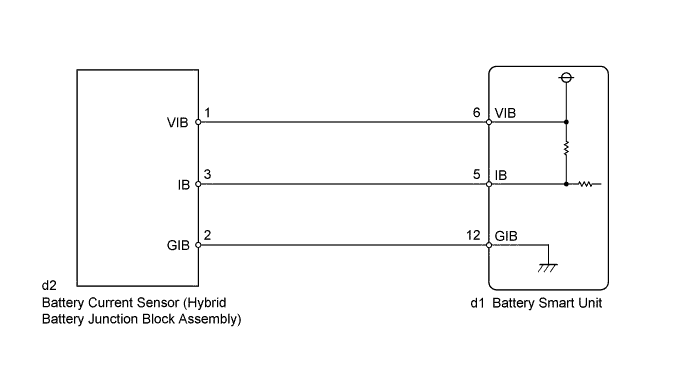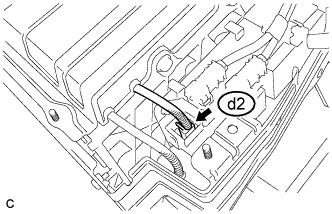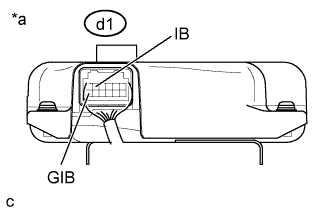DTC P0ABF-123 Hybrid Battery Pack Current Sensor Circuit |
DTC P0AC1-123 Hybrid Battery Pack Current Sensor Circuit Low |
DTC P0AC2-123 Hybrid Battery Pack Current Sensor Circuit High |
for Preparation Click here
DESCRIPTION
- The battery current sensor, which is mounted on the positive cable side of the HV battery, detects the amperage that flows into the HV battery. The battery smart unit receives a voltage, which varies between 0 and 5 V in proportion to the amperage, at its IB terminal from the battery current sensor. An output voltage of the battery current sensor below 2.5 V indicates that the HV battery is being charged, and above 2.5 V indicates that the HV battery is being discharged. The power management control ECU determines the charging and discharging amperage of the HV battery based on the signals that are input to its IB terminal from the battery smart unit, and calculates the SOC (state of charge) of the HV battery through the accumulated amperage.

| DTC No. | INF Code | DTC Detection Condition | Trouble Area |
| P0ABF | 123 | Power source voltage of the battery current sensor is excessively low/high. (1 trip detection logic) |
|
| P0AC1 | The battery current sensor output value is excessively low. (1 trip detection logic) | ||
| P0AC2 | The battery current sensor output value is excessively high. (1 trip detection logic) |
| DTC No. | Data List |
| P0ABF-123 P0AC1-123 P0AC2-123 | Batt Pack Current Val |
MONITOR DESCRIPTION
If the battery smart unit detects a malfunction in the battery current sensor, the power management control ECU illuminates the MIL and set a DTC.MONITOR STRATEGY
| Related DTCs | P0ABF (INF 123): Power-supply circuit for current sensor malfunction (GND short/ +B short) P0AC1 (INF 123): Current sensor circuit malfunction (GND short) P0AC2 (INF 123): Current sensor circuit malfunction (open) |
| Required sensors / components | Battery current sensor |
| Frequency of operation | Continuous |
| Duration | TMC's intellectual property |
| MIL operation | TMC's intellectual property |
| Sequence of operation | None |
TYPICAL ENABLING CONDITIONS
| The monitor will run whenever the following DTCs are not present | TMC's intellectual property |
| Other conditions belong to TMC's intellectual property | - |
TYPICAL MALFUNCTION THRESHOLDS
| TMC's intellectual property | - |
COMPONENT OPERATING RANGE
| Battery smart unit | DTC P0ABF (INF 123) is not detected DTC P0AC1 (INF 123) is not detected DTC P0AC2 (INF 123) is not detected |
CONFIRMATION DRIVING PATTERN
- Connect the Techstream to the DLC3.
- Turn the ignition switch to ON (IG) and turn the Techstream on.
- Clear the DTCs (even if no DTCs are stored, perform the clear DTC procedure).
- Turn the ignition switch off and wait for 30 seconds or more.
- Turn the ignition switch to ON (IG) and wait for 10 seconds or more.
- Perform the universal trip.
- Enter the following menus: Powertrain / HV / Trouble Codes.
- Read the current DTCs.
- HINT:
- If a current DTC is output, the system is malfunctioning.
- If a current DTC is not output, perform the following procedure.
- Check that permanent DTCs are cleared. If no permanent DTC is output, the system is normal.
WIRING DIAGRAM

INSPECTION PROCEDURE
- CAUTION:
- Before inspecting the high-voltage system, take safety precautions to prevent electrical shocks, such as wearing insulated gloves and removing the service plug grip. After removing the service plug grip, put it in your pocket to prevent other technicians from accidentally reconnecting it while you are working on the high-voltage system.
- After removing the service plug grip, wait for at least 10 minutes before touching any of the high-voltage connectors or terminals. After waiting for 10 minutes, check the voltage at the terminals in the inspection point in the inverter with converter assembly. The voltage should be 0 V before beginning work (Click here).
- HINT:
- At least 10 minutes is required to discharge the high-voltage capacitor inside the inverter with converter assembly.
- NOTICE:
- After turning the ignition switch off, waiting time may be required before disconnecting the cable from the negative (-) auxiliary battery terminal. Therefore, make sure to read the disconnecting the cable from the negative (-) auxiliary battery terminal notices before proceeding with work (Click here).
- HINT:
- After the repair, clear the DTCs and perform the following procedure to check that DTCs are not output.
- Turn the ignition switch to ON (IG) and wait for 10 seconds or more.
| 1.CHECK DTC OUTPUT (HYBRID CONTROL) |
Connect the Techstream to the DLC3.
Turn the ignition switch to ON (IG).
Enter the following menus: Powertrain / Hybrid Control / Trouble Codes.
Check and record any HV system DTCs, INF codes and freeze frame data.
Read output DTCs (Click here).
- Result:
Result Proceed to P0AFC-123 is not output. A P0AFC-123 is also output. B
Turn the ignition switch off.
Disconnect the Techstream from the DLC3.
|
| ||||
| A | |
| 2.CHECK HARNESS AND CONNECTOR (HYBRID BATTERY JUNCTION BLOCK ASSEMBLY - BATTERY SMART UNIT) |
- NOTICE:
- Be sure to wear insulated gloves.
Check that the service plug grip is not installed.
- NOTICE:
- After removing the service plug grip, do not turn the ignition switch to ON (READY), unless instructed by the repair manual because this may cause a malfunction.
Remove the No. 1 hybrid battery shield sub-assembly (Click here).
Remove the No. 2 hybrid battery shield sub-assembly (Click here).
Disconnect only the d1 connector of the battery smart unit.
Disconnect the d2 battery current sensor connector from the hybrid battery junction block assembly.
 |
Measure the resistance according to the value(s) in the tables below.
- Standard Resistance (Check for Open):
Tester Connection Switch Condition Specified Condition d1-5 (IB) - d2-3 (IB) Ignition switch off Below 1 Ω d1-12 (GIB) - d2-2 (GIB) Ignition switch off Below 1 Ω d1-6 (VIB) - d2-1 (VIB) Ignition switch off Below 1 Ω
- Standard Resistance (Check for Short):
Tester Connection Switch Condition Specified Condition d1-5 (IB) or d2-3 (IB) - Body ground and other terminals Ignition switch off 10 kΩ or higher d1-12 (GIB) or d2-2 (GIB) - Body ground and other terminals Ignition switch off 10 kΩ or higher d1-6 (VIB) or d2-1 (VIB) - Body ground and other terminals Ignition switch off 10 kΩ or higher
Text in Illustration *a Rear view of wire harness connector
(to Battery Smart Unit)*b Front view of wire harness connector
(to Hybrid Battery Junction Block Assembly)
 |
- HINT:
- Because the battery harness is not available as a supply part, if the harness cannot be repaired, replace the HV battery assembly.
Connect the battery smart unit connector.
Connect the battery current sensor connector to the hybrid battery junction block assembly.
Install the No. 2 hybrid battery shield sub-assembly.
Install the No. 1 hybrid battery shield sub-assembly.
|
| ||||
| OK | |
| 3.CHECK BATTERY SMART UNIT (VIB VOLTAGE) |
- NOTICE:
- Be sure to wear insulated gloves.
Check that the service plug grip is not installed.
- NOTICE:
- After removing the service plug grip, do not turn the ignition switch to ON (READY), unless instructed by the repair manual because this may cause a malfunction.
Remove the No. 1 hybrid battery shield sub-assembly (Click here).
Connect the cable to the negative (-) auxiliary battery terminal.
Turn the ignition switch to ON (IG).
Measure the voltage according to the value(s) in the table below.
- Standard Voltage:
Tester Connection Switch Condition Specified Condition d1-6 (VIB) - d1-12 (GIB) Ignition switch ON (IG) 4.6 to 5.4 V
Text in Illustration *a Component with harness connected
(Battery Smart Unit)
 |
- NOTICE:
- Turning the ignition switch to ON (IG) with the service grip removed causes other DTCs to be stored. Clear the DTCs after performing this inspection.
Turn the ignition switch off.
Disconnect the cable from the negative (-) auxiliary battery terminal.
Install the No. 1 hybrid battery shield sub-assembly.
|
| ||||
| OK | |
| 4.CHECK BATTERY SMART UNIT |
- CAUTION:
- Be sure to wear insulated gloves.
Check that the service plug grip is not installed.
- NOTICE:
- After removing the service plug grip, do not turn the ignition switch to ON (READY), unless instructed by the repair manual because this may cause a malfunction.
Remove the No. 1 hybrid battery shield sub-assembly (Click here).
Connect the cable to the negative (-) auxiliary battery terminal.
Turn the ignition switch to ON (IG).
Measure the voltage according to the value(s) in the table below.
- Standard Voltage:
Tester Connection Switch Condition Specified Condition d1-5 (IB) - d1-12 (GIB) Ignition switch ON (IG) 2.46 to 2.54 V
Text in Illustration *a Component with harness connected
(Battery Smart Unit)
 |
- NOTICE:
- Turning the ignition switch to ON (IG) with the service grip removed causes other DTCs to be stored. Clear the DTCs after performing this inspection.
Turn the ignition switch off.
Disconnect the cable from the negative (-) auxiliary battery terminal.
Install the No. 1 hybrid battery shield sub-assembly.
|
| ||||
| OK | ||
| ||
